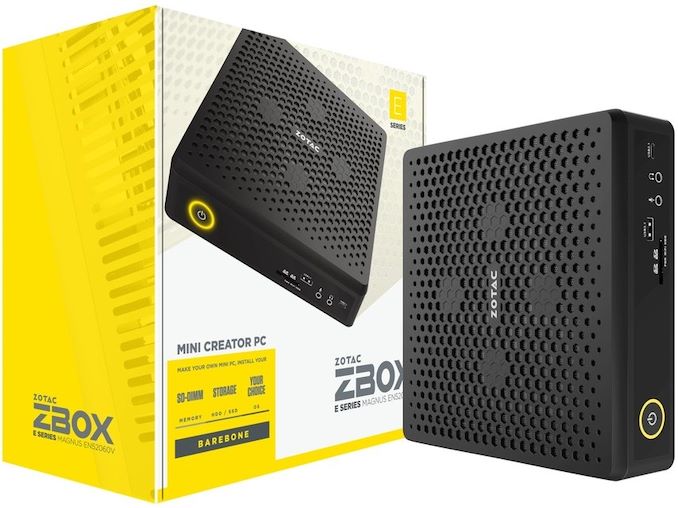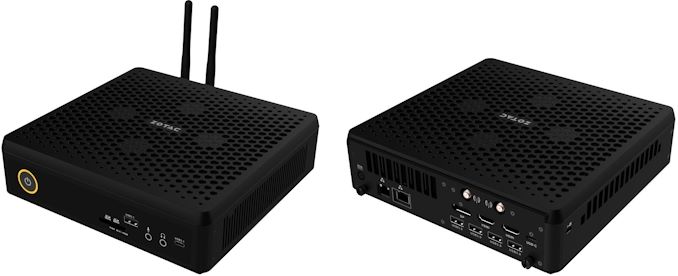ZOTAC Unveils Zbox Magnus EN52060V: A UCFF PC with GeForce RTX 2060 & 2.5 GbE
by Anton Shilov on February 27, 2020 10:30 AM EST- Posted in
- Desktop
- ZOTAC
- ZBOX
- Turing
- GeForce RTX

Zotac has quietly added a new mainstream gaming barebones system into its lineup of ultra-compact systems. With its quad-core Intel processor and NVIDIA’s GeForce RTX 2060 graphics card, the new Zbox Magnus EN52060V promises the performance of a mid-range mobile PC for gamers, but at a lower price and with all advantages that a desktop can offer.
The new barebones system comes in ZOTAC’s regular 2.65-liter Zbox Magnus EN chassis, which is just 62.2 mm (2.45 inches) tall. The Zbox Magnus EN52060V UCFF PC barebones is based on Intel’s quad-core Core i5-9300H processor (4C/8T, 2.40 GHz – 4.10 GHz, 45 W) accompanied by NVIDIA’s GeForce RTX 2600 discrete GPU with 6 GB of GDDR6 memory. The system can be equipped with up to 32 GB of DDR4-2600 memory, an M.2-2280 SSD with a PCIe 3.0 x4 or SATA interface, and a 2.5-inch storage device.
The barebones system uses a mobile processor in an FCBGA1440 packaging, so it cannot be upgraded. Meanwhile, it is unclear whether the system uses a soldered-down discrete GPU, or an MXM module that could theoretically be upgraded.
When it comes to connectivity, the Zbox Magnus EN52060V supports a Wi-Fi 6 + Bluetooth 5 adapter, two RJ-45 connectors (2.5 GbE + GbE), two USB 3.1 Type-C connectors, four USB 3.0 Type-A ports, four display outputs (a DP 1.4, two HDMI 2.0b, one USB-C), an SD card reader, and two 3.5-mm audio jacks for headphones and a microphone.
| ZOTAC's Zbox Magnus EN-Series GeForce RTX Barebones | ||
| Magnus EN52060V Zbox-EN52060V |
||
| CPU | Intel Core i5-9300H 4C/8T 2.4 GHz - 4.1 GHz 8 MB 45 W |
|
| GPU | NVIDIA GeForce RTX 2060 | |
| Memory | 2 × DDR4 SO-DIMM slots up to 32 GB of DDR4-2600 memory |
|
| Storage | M.2 | M.2 2280 slot for PCIe/SATA SSD |
| DFF | 1 × 2.5" SSD/HDD | |
| Card Reader | SD | |
| Wireless | Killer 1650 802.11ax Wi-Fi + BT 5 | |
| Ethernet | 1 × Gigabit Ethernet with RJ45 1 × 2.5 Gigabit Ethernet with RJ45 |
|
| Display Outputs | 1 × DisplayPort 1.4 2 × HDMI 2.0b 1 × USB-C |
|
| Audio | 3.5 mm audio-in 3.5 mm audio-out |
|
| USB | 5 x USB 3.1 Type-A 1 x USB 3.1 Type-C |
|
| Thunderbolt 3 | - | |
| PSU | External | |
| OS | ? | |
| Additional Details | Link | |
ZOTAC already lists its Zbox Magnus EN52060V on its website, so it is reasonable to expect it to become available shortly. As for pricing, while Zotac has not announced anything at this time, based on its specifications we expect that this should end up the cheapest of Zotac's GeForce RTX-equipped Magnus EN-series PCs.
Related Reading:
- CES 2020: ZOTAC’s Inspire Studio SFF PCs for Creators w/ 8-Core CPU & GeForce RTX
- ZOTAC Expands MEK Lineup with MEK Mini and MEK Ultra
- Zotac at CES 2018: ZBOX MAGNUS Upgraded with Coffee
Source: ZOTAC (via Hermitage Akihabara)











16 Comments
View All Comments
Dug - Monday, March 2, 2020 - link
Do you realize this is portable? Do you realize people use portable devices besides sitting at a desk.Do you realize that 90% of households don't have an Ethernet port located in the room their computer is, and can't put one in because they are in an apartment, rented house, or other reasons?
People care more about having wireless than Ethernet because it works, and solves a problem. But I guess you are right, wireless is just GaMeR shit?
Now if I could only find an Ethernet adapter for my phone.
AdditionalPylons - Thursday, February 27, 2020 - link
Finally multi-gigabit ethernet is starting to show up, but it's sad it's taking so long. I guess most vendors don't care, and people with a faster-than-1Gbps-NAS is still rare, internet connection even rarer. But seeing as the controllers are less than $5 (e.g. the Intel i225-V is $2.4 according to https://www.servethehome.com/current-intel-i225-2-... ) it would be a nice differentiator and would definitely help making the product feel more future-proof.And Anton, could perhaps please add the "Nbase-T" tag on top so that gear with this is easier to find on your site?
azazel1024 - Thursday, February 27, 2020 - link
IMHO switch support at a reasonable cost is the biggest issue. Which I don't get if 2.5GbE is coming at a cost of less than $5 a port for an INTEL chip and Realtek is probably a little cheaper. I realize it is ~$50 for a retail single port card, but more components as well as profits, etc. factoring in there. Power budget also seems roughly as low for a 2.5GbE port now as a 1GbE port was 5-6 years ago (if not better). So active cooling and PSU aren't a concern.Seems like you could roll 5, 8, 16, 24 and 48 port 2.5GbE switches at reasonable prices. I realize there is more than just the actual network adapter costs to a switch since it has to handle the actual flow from each port, switch controller, memory, management interface for semi-managed, L2 and L3 switches, etc. Lots more than just the port.
But unless that stuff is incredibly lacking in development, $5 a port means a $160 16 port switch. Figure tack on another $80-100 for the management layer and all of the stuff to support those ports. Maybe $160 for an 8 port, $260 for a 16 port. $340 for a 24 port and $700 for a 48 port. I think there would be a lot of buyers at those price points. Heck, I'd be knocking down the door for a 16 port 2.5GbE switch.
5GbE and 10GbE would be really nice, but a >2x speed increase would be really swell right now. I don't suffer in silence though and I run 2x1GbE links from my server to my 24 port core switch and 2x1GbE links from my desktop to my core switch. However, the network layer is still generally the weak link in data transfers between machines, even with SMB Multichannel doing its magic. My RAID 0 2x3TB storage array in each machine is more than capable of exceeding the 235MB/sec hard limit of that link (9k jumbo frames enabled, TCP/IP and SMB protocol losses). Reviews I've seen of 2.5GbE seem to show it managing about 255-270MB/sec. A single 2.5GbE link would be a little more than the current performance of my 2x1GbE link.
But why stop there, I have the wiring, might as well do a 2x2.5GbE link and somewhat more than double my current performance. I am sure some day that'll feel like a limitation also, but it is way faster than my HDD array can handle and roughly as fast as the SSD boot drive in my server or the boot/app drive in my desktop can manage being limited to SATA3 interface. I know NVME SSDs would crush that link, but I am not too greedy. I don't need multiple GB/sec right now. ~500-550MB/sec link speed could probably make me pretty happy for a few years.
Single 2.5GbE links for access points and router would prevent those from being bottle necks for 802.11ax equipped devices for some nice future proofing there. Hopefully I'll see laptops start having 2.5GbE ports also.
It feels like we are on the cusp of 2.5GbE being the new standard "everything except your printer which is still stuck with fast Ethernet ports" has one.
But SOHO/residential switches that are affordable and/or have sufficient ports seems to be the real bottleneck right now. Only a few companies are making them and a lot of times they are some weird thing where it has like 4x 2.5GbE ports, 2x5GbE ports, 1x10GbE port and 2-4x1GbE ports. I mean, I can see how maybe that would be useful in a test lab or small video development shop that needs to network work a couple/few workstations at higher speeds to one 10GbE NAS. But I still haven't seen any standard 8, 16, 24 or 48 2.5GbE switches (or 5GbE, but let's start somewhere with 2.5GbE switches). Heck, I'd even be okay with like a 24 port switch with 8 2.5GbE and 16 1GbE ports.
TheinsanegamerN - Friday, February 28, 2020 - link
Tell me about it. 2.5G should be everywhere right now. It cant cost that much more over 1G controllers if 2.5G prces are that low.I went looking for 2.5G switches, now that the PCIe NICs are down to around $35. Cheapest switch I could find was over $200. That's rediculous. Buffalow makes a sub $200 model with 5x2.5G ports, but only in japan.
tygrus - Thursday, February 27, 2020 - link
Need more Wireless routers with 2.5G or better physical ports.How about a combo switch combining a mixture of 3 port types:
4x 1/2.5G copper
2x 1/2.5/5G copper
2x upto 10G (SFP+)
..or..
8x 1/2.5G copper
4x 1/2.5/5G copper
2x upto 10G (SFP+)
TheinsanegamerN - Friday, February 28, 2020 - link
I really dont see the point of 5G, i cant find a 5G ethernet adapter anywhere outside of a few poorly reviewed usb options.